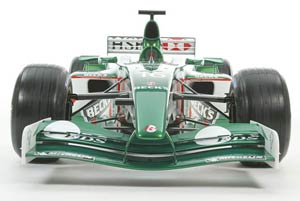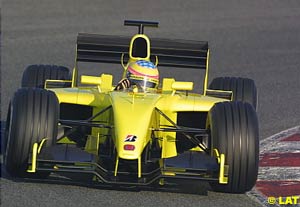
This week's Grapevine brings you |
It's quite interesting to learn that Jaguar are blaming their wind tunnel for the deficiencies of the front wing. It's a fair enough assessment, but arguably a very simplistic view on what seems to be involved overall.
When working on the aerodynamics for this year's car, the engineers were given a set of parameters which defined dimensions, and critical performance criteria. These were set early on, and it seems that a failure to communicate a couple of critical changes during the design evolution could be to blame for the current aero issue: as the design evolved, in the interest of pursuing solid handling, the suspension is keyed to ensuring confidence on turning in to corners. Achieving this has required some compromise in other areas, including a slight increase to pitch under braking and acceleration.
Wind tunnels are immensely complex beasts, allowing teams to consider all sorts of interesting circumstances as part of the development cycle, so naturally the effect of pitch on the aerodynamics is measured and considered. However, it's rare to worry about parameters outside the car's performance criteria, so the effect of the car pitching more under braking than expected is, really, highly significant: the wing partially stalls. In Jaguar's case, this means that just when the most downforce is called for, under hard braking, the front wing is suddenly becoming inefficient, the driver loses downforce, and the front of the car loses grip, compromising turn in. Badly.
Adding insult to injury, the stall causes air to be spilled around the wing, spoiling the air flow under the car and around the wheels.
Looking at solutions, there are a couple of routes open. Attempting to keep the new front wing would require changes to the suspension geometry, which in turn is likely to require a revision to the front wing to improve airflow round the revised suspension. Or, the wing needs to be updated so that it can handle the new pitch limit.
On the positive front, whilst painful to discover there was a problem, the straight line testing has been useful for both isolating the specific areas on the wing which are struggling, and double check the parameters for solving the problem. A relatively simple modification can sort out the immediate issue of the stall at a small cost in efficiency, so effective testing can continue whilst the aero team work on recovering the original position.
With many of the launches already taken place, there's plenty of feedback from first tests of new cars, and this is as good a time as it gets to have a look at what's going on.
Which is not very good news for Renault, who stated at their launch that they would be disappointed not to finish in the top four this year. That is going to be a tough challenge indeed. The new car is, certainly, a much better proposition than last year's. Out of the box, its performance is a little down on the last model, but there's a lot of work to go into setting it up. The new engine is producing useful power - better than at the end of last season, at least - but has a way to go before matching Ferrari or BMW. Positively for them, the engine does appear to have a lot of development potential, though it raises the question as to why they haven't been doing more to extract that potential already.
Jordan, too, are concerned about Sauber's early pace. Again this season, their key competition are BAR, who must be beaten, but the early indications are that their car has the early edge again. The team have been working hard on an issue which has been plaguing them for the last couple of seasons: they can get excellent performance from tyres for a couple of laps, then they go off quickly. Some could say that Heinz Harald Frentzen's comments before parting Jordan have had some impact here, as the new car appears, initially, to be less critical on tyres.
However, the biggest story, at least for fans looking for competition at the front, is that Williams's new car is a monster. They aimed for reliability, power and improved aerodynamics - and appear to be delivering all three, big time. Initial testing has been impossibly smooth for a new car launch, with what seems to be a record-low count of significant problems. And whilst it is impossible to compare absolute times against Ferrari or McLaren, as sandbagging and changing conditions make testing times misleading, it is fair to say that the new Williams is looking very strong on the circuit. More than that, back in the pits, the engineers are carrying a very tangible aura of confidence.
This new BMW-Williams might not prove to be a world-beater, especially considering Ferrari have not brought out their new car yet, but it's certainly looking set to provide a serious challenge.
![]() Jaguar Blowing in the Wind
Jaguar Blowing in the Wind
 Apparently, the bottom line for Jaguar's problem is that their new front wing, which should have offered a significant efficiency gain, is actually performing worse than last year's offering. Saying there's just a lack of downforce would be misleading, as the interactions are highly complex, but anything which is out to the tune of more than ten percent in efficiency terms is interesting enough to warrant a closer look!
Apparently, the bottom line for Jaguar's problem is that their new front wing, which should have offered a significant efficiency gain, is actually performing worse than last year's offering. Saying there's just a lack of downforce would be misleading, as the interactions are highly complex, but anything which is out to the tune of more than ten percent in efficiency terms is interesting enough to warrant a closer look!
![]() The 2002 Cars: First Impressions
The 2002 Cars: First Impressions
 Sauber, despite having just officially launched their new car, have in fact been running it for a while. Claims that it is 80 percent new are a misleading statistic: Williams, when they "evolve" their cars year on year, expect to carry over around ten percent of their parts; most things are, literally, new, but it's basically an evolution, building on a successful concept. Sauber's 2002 chassis is actually following that pattern, despite the extensive effort required on aerodynamics in order to accommodate the bigger radiators needed for the new Ferrari engine. It's no surprise, therefore, to learn that they have raised their game, and expect the new car's performance to be very close to on a par with Ferrari's performance at the start of last season.
Sauber, despite having just officially launched their new car, have in fact been running it for a while. Claims that it is 80 percent new are a misleading statistic: Williams, when they "evolve" their cars year on year, expect to carry over around ten percent of their parts; most things are, literally, new, but it's basically an evolution, building on a successful concept. Sauber's 2002 chassis is actually following that pattern, despite the extensive effort required on aerodynamics in order to accommodate the bigger radiators needed for the new Ferrari engine. It's no surprise, therefore, to learn that they have raised their game, and expect the new car's performance to be very close to on a par with Ferrari's performance at the start of last season.
 From the outset, Jordan's new car has performed relatively well. There have been minor issues, quickly resolved, and initial feedback on the engine is cautiously optimistic. Power level is not where they hoped, but not far short, and expected to improve. The fuel consumption level is highly configurable - although hundreds of testing laps are still needed to set up the mappings effectively. Odds on beating BAR again are good, but no-one is sure how they'll stack against Sauber over the coming season.
From the outset, Jordan's new car has performed relatively well. There have been minor issues, quickly resolved, and initial feedback on the engine is cautiously optimistic. Power level is not where they hoped, but not far short, and expected to improve. The fuel consumption level is highly configurable - although hundreds of testing laps are still needed to set up the mappings effectively. Odds on beating BAR again are good, but no-one is sure how they'll stack against Sauber over the coming season.
Please Contact Us for permission to republish this or any other material from Atlas F1.
|
Volume 8, Issue 5
Atlas F1 Exclusive
The FIA's Court of Appeal: Final Answer?
Williams 2002: Improving the Average
Articles
Miracle at Imola
Columns
Rear View Mirror
Bookworm Critique
The Weekly Grapevine
> Homepage |
